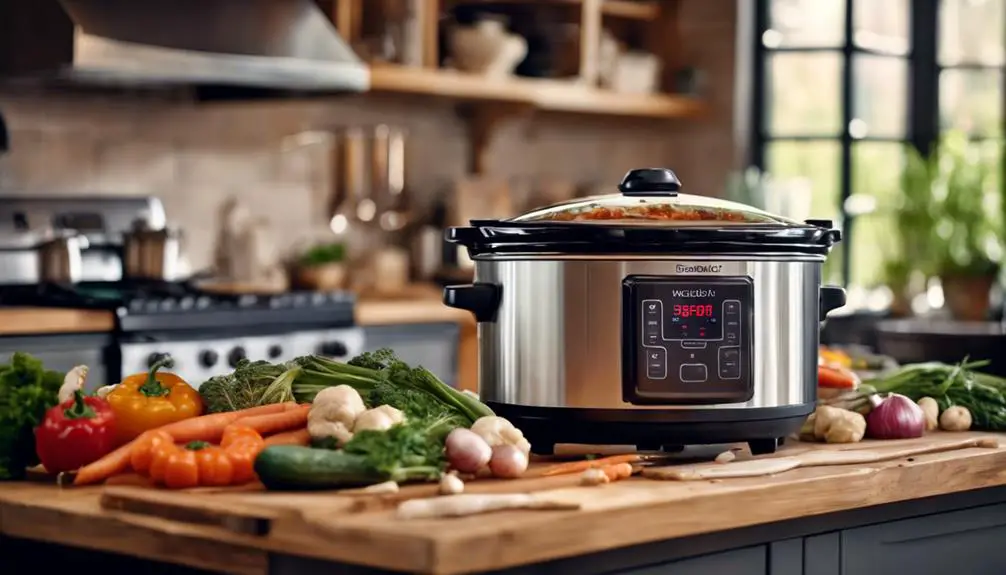Did you know that a slow cooker operates by utilizing a low and steady heat source to cook your meals slowly over several hours?
This method of cooking may seem simple, but there's more to it than meets the eye.
Understanding how a slow cooker functions can lead to delicious and convenient meal preparations.
So, let's uncover the science behind this popular kitchen appliance and discover how it transforms raw ingredients into mouthwatering dishes with minimal effort on your part.
Key Takeaways
- Slow cookers operate by applying consistent low heat for unattended cooking.
- Heat distribution ensures even cooking from base to sides for flavorful dishes.
- Inner pot and heating element work together for optimal cooking conditions.
- Slow cooking retains nutrients, tenderizes meat, and enhances flavors with minimal effort.
What Is a Slow Cooker?
A slow cooker is a kitchen appliance designed for unattended cooking at low temperatures. It operates by applying consistent heat to cook food slowly over an extended period. The slow cooking process allows for flavors to meld together, meat to become tender, and dishes to develop rich tastes.
In a slow cooker, the stoneware vessel heats up gradually, ensuring that the food is cooked evenly without scorching. The low temperature setting of a slow cooker is essential for the slow cooking method, as it gently simmers ingredients over several hours. This method is ideal for preparing meals like stews, soups, and roasts, where long cooking times at low temperatures are required to achieve the desired results.
Slow cookers are versatile appliances that can accommodate various recipes, making them a convenient tool for busy individuals looking to enjoy home-cooked meals without constant monitoring.
Understanding Slow Cooker Components
Let's break down the key components of a slow cooker.
The inner pot plays a crucial role in ensuring even heat distribution during cooking.
Understanding how the heating element functions will give you insight into how the slow cooker maintains its steady temperature range.
Key Components Explained
Exploring the inner workings of a slow cooker reveals a complex interplay of key components essential for its efficient operation. The slow cooker typically consists of a sturdy stoneware vessel that ensures even heat distribution, allowing ingredients to cook thoroughly. Accompanied by a lid, this component helps to trap moisture and heat inside the slow cooker, enhancing the cooking process.
To provide cooking flexibility, most slow cookers are equipped with settings such as low, medium, high, and keep warm options. Operating at temperatures ranging from 79–93°C, the slow cooker gradually cooks food over an extended period, resulting in tender and flavorful dishes.
Understanding these key components is crucial for optimizing the performance of your slow cooker and achieving delicious meals.
Inner Pot Function
The inner pot of a slow cooker, crafted from glazed ceramic, plays a pivotal role in evenly distributing heat and moisture to cook ingredients thoroughly. Here's how it functions:
- The inner pot acts as a heat reservoir, ensuring even distribution of heat for thorough cooking.
- Glazed ceramic helps retain moisture and flavors during the slow cooking process.
- Different inner pot sizes, ranging from 500mL to 7L, accommodate various batch sizes for meals.
- This component interacts closely with the heating element to facilitate slow and even cooking of food.
- The magic of slow cooking happens within the inner pot, where ingredients are gently cooked to perfection.
Heating Element Overview
Positioned at the base of the slow cooker, the heating element serves as the essential component responsible for generating and maintaining the consistent low-level heat required for the slow cooking process. This heating element is crucial for creating a steady temperature within the cooking vessel, ensuring that your food cooks evenly.
By utilizing the heating element over an extended period, slow cookers tenderize tough cuts of meat and develop rich flavors in dishes. The heating element establishes the optimal cooking environment, gently cooking your ingredients to perfection.
Understanding the role of the heating element in your slow cooker allows you to appreciate how it transforms raw ingredients into delicious, tender meals with minimal effort on your part.
Heat Distribution in Slow Cooking
As heat rises from the base to the sides of the vessel in a slow cooker, it ensures even cooking of the food. The heat distribution in a slow cooker plays a crucial role in the cooking process, allowing for gentle and consistent cooking over an extended period. Here are some key points to consider:
- The temperature settings on a slow cooker, such as low and high, control how much heat is applied during the cooking process.
- Cooking times differ between the low and high settings, with low settings requiring more time for thorough cooking.
- Specifying the exact temperature inside a slow cooker can be challenging due to the nature of slow cooking.
- The even heat distribution in a slow cooker helps in cooking ingredients uniformly, avoiding hotspots.
- Slow cookers offer the benefit of slowly cooking food at a consistent temperature, resulting in flavorful and tender dishes.
Benefits of Slow Cooker Cooking
When using a slow cooker, you benefit from cooking efficiency as the low and slow process retains more nutrients in your food. Additionally, flavors are enhanced through extended simmering, creating rich and delicious meals every time.
This method also saves you time by requiring minimal hands-on effort in meal preparation, making it a convenient option for busy individuals.
Cooking Efficiency
Slow cooker cooking efficiency shines through the retention of nutrients, enhanced flavors, time-saving unattended operation, and minimal energy consumption. When utilizing a slow cooker, you benefit from:
- Retaining nutrients in your food with the low and steady cooking temperature.
- Experiencing enhanced flavors as ingredients simmer slowly and blend together.
- Saving time by allowing unattended cooking for hours without constant monitoring.
- Being economical, as slow cookers use energy equivalent to only one and a half 100-watt light bulbs.
- Enjoying the convenience of preparing delicious meals with minimal effort, making it ideal for busy individuals seeking a hassle-free cooking experience.
Flavor Enhancement
Enhancing flavors in slow cooker dishes is achieved through the gradual melding of ingredients over an extended period, resulting in a richer and more intense taste experience.
Tough cuts of meat, when cooked slowly in a crock-pot, benefit from the long cooking time and gentle heat, becoming tender and more flavorful.
The low, steady heat in a slow cooker helps vegetables release their natural juices, allowing them to absorb the flavors of the cooking liquid and other ingredients present.
Herbs, spices, and seasonings have ample time to infuse deeply into the dish, creating a well-developed and robust taste profile.
Time-saving Meal Prep
To maximize efficiency in meal preparation and enjoy the benefits of slow cooker cooking, consider incorporating time-saving techniques that streamline your cooking process. When utilizing a slow cooker for time-saving meal prep, you can experience various advantages such as:
- Unattended Cooking: Allows you to multitask or focus on other activities while your meal cooks.
- Enhanced Flavors and Textures: Slow cooking tenderizes meats and enhances the flavors of spices and herbs.
- Retained Nutrients: Ensures that the nutrients in your ingredients are preserved during the slow cooking process.
- Economical Meals: Helps in turning budget-friendly ingredients into delicious and satisfying dishes.
- Efficient Energy Usage: Slow cookers are energy-efficient appliances that consume low power while preparing your meals.
Tips for Optimal Slow Cooker Use
For optimal results when using a slow cooker, ensure it's at least half full to promote even heat distribution and thorough cooking. This will help prevent hot spots and ensure that all ingredients are cooked evenly.
When cooking meat and poultry in a slow cooker, it's essential to use a food thermometer to check for safe internal temperatures. Preheating the slow cooker and adding hot liquids can jumpstart the cooking process, leading to faster results. Additionally, placing vegetables on the bottom or sides of the slow cooker can help in achieving consistent and thorough cooking.
To avoid risks of foodborne illnesses, refrain from cooking on the warm setting as this can cause food to linger in the temperature danger zone. By following these tips and utilizing the slow cooker efficiently, you can prepare delicious and safely cooked meals for yourself and others.
Converting Recipes for Slow Cooking
When adapting recipes for slow cooking, consider the adjustments necessary for optimal results. Converting recipes to suit a slow cooker involves more than just transferring ingredients to a pot; it requires careful consideration of various factors to ensure that the flavors and textures are enhanced.
Here are some key points to keep in mind:
- Tough Cuts of Meat: Opt for tougher cuts of meat like chuck roast or brisket, as the long, moist cooking process in a slow cooker will tenderize them beautifully.
- Liquid Ratios: Adjust the amount of liquid in the recipe, as slow cooking retains more moisture. Reduce the liquid compared to traditional cooking methods to prevent the dish from becoming too watery.
- Cooking Times: Be mindful of cooking times when converting recipes. Slow cookers operate at low temperatures, so you may need to increase the cooking time to ensure everything is fully cooked.
- Low Temperatures: Slow cooking at low temperatures prevents burning and allows flavors to develop more fully over time.
- Flavors and Textures: Slow cooking can enhance flavors and textures in dishes, making them more rich and complex.
Energy Efficiency of Slow Cookers
Slow cookers demonstrate energy efficiency by utilizing the heat equivalent to one and a half 100-watt light bulbs during operation. This makes them highly efficient compared to conventional cooking methods.
The contained heat within the slow cooker not only reduces overall energy consumption but also promotes unattended cooking, making it a convenient and cost-effective option for busy individuals.
By harnessing low, steady heat over an extended period, slow cookers effectively tenderize meats and develop rich flavors while consuming minimal energy. This energy-efficient approach is ideal for those looking to save time and reduce energy costs without compromising on taste or nutrition.
Embracing slow cooking can lead to significant savings on electricity bills while still enjoying delicious, home-cooked meals. Therefore, investing in a slow cooker isn't only a culinary choice but also a practical and eco-friendly decision to manage energy consumption effectively.
Exploring Slow Cooker Recipes
Effortlessly exploring a range of delectable dishes, slow cooker recipes offer a convenient and flavorful culinary experience. When you delve into slow cooker recipes, you encounter a world of possibilities that elevate your cooking game. Here are some key points to consider:
- Tenderizes Tough Cuts of Meat: Slow cooker recipes typically involve long, low-temperature cooking that transforms tough cuts of meat into succulent, melt-in-your-mouth delicacies.
- Minimal Effort, Maximum Flavor: With ingredients combined in the pot and left to cook for hours, slow cooker recipes require minimal effort while delivering maximum flavor.
- Versatile Dishes: From hearty soups and rich stews to tender roasts and indulgent desserts like cobblers, slow cooker recipes cover a wide array of culinary delights.
- Convenience: Busy schedules? No problem. Slow cooker recipes are perfect for individuals on-the-go, offering a convenient way to enjoy homemade meals.
- Flavorful Creations: As ingredients simmer slowly, flavors meld together, resulting in rich and delicious meals that require little hands-on time but pack a punch in taste.
Frequently Asked Questions
What Is the Difference Between a Crockpot and a Slow Cooker?
When it comes to slow cookers, the main difference between a Crock-Pot and other brands lies in branding. While they all offer similar cooking times, heat distribution, size options, temperature control, and cooking methods, each brand may vary in energy efficiency, cleaning tips, and versatility features.
What Cannot Be Cooked in a Slow Cooker?
You can't cook dried kidney beans or legume seeds in a slow cooker due to toxic lectin phytohemagglutinin. Soak beans for 5 hours and boil for 30 minutes to deactivate harmful lectins. Follow safe bean preparation guidelines to avoid poisoning risks.
What Are the Disadvantages of a Slow Cooker?
Are you aware of the drawbacks of using a slow cooker? Temperature control, time commitment, flavor retention, limited capacity, ingredient prep, uneven cooking, energy efficiency, and the cleaning process can present challenges when using one.
Do You Have to Put Water in a Slow Cooker?
You should always put water or liquid in a slow cooker. It helps with meat tenderness, food texture, flavor retention, ingredient distribution, cooking time, and heat distribution. Proper liquid levels are crucial for successful recipe adaptation.
Conclusion
Now that you understand how a slow cooker works, you hold the key to unlocking a world of flavorful, tender dishes with minimal effort. Embrace the magic of slow cooking, where time and heat dance together to create meals that will tantalize your taste buds and warm your soul.
So go ahead, dust off that slow cooker and let the culinary journey begin! Your next delicious creation awaits.





